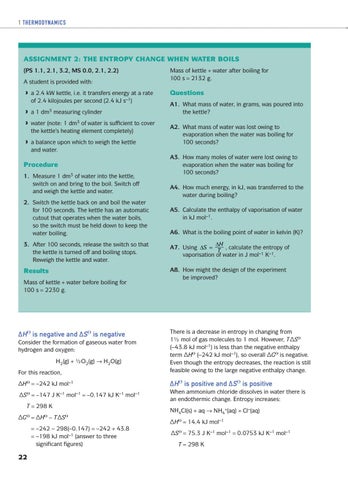1 THERMODYNAMICS
ASSIGNMENT 2: THE ENTROPY CHANGE WHEN WATER BOILS (PS 1.1, 2.1, 3.2, MS 0.0, 2.1, 2.2) A student is provided with:
›
a 2.4 kW kettle, i.e. it transfers energy at a rate of 2.4 kilojoules per second (2.4 kJ s−1)
› ›
a 1 dm3 measuring cylinder
›
a balance upon which to weigh the kettle and water.
water (note: 1 dm3 of water is sufficient to cover the kettle’s heating element completely)
Procedure 1. Measure 1 dm3 of water into the kettle, switch on and bring to the boil. Switch off and weigh the kettle and water. 2. Switch the kettle back on and boil the water for 100 seconds. The kettle has an automatic cutout that operates when the water boils, so the switch must be held down to keep the water boiling.
Mass of kettle + water after boiling for 100 s = 2132 g.
Questions A1. What mass of water, in grams, was poured into the kettle? A2. What mass of water was lost owing to evaporation when the water was boiling for 100 seconds? A3. How many moles of water were lost owing to evaporation when the water was boiling for 100 seconds? A4. How much energy, in kJ, was transferred to the water during boiling? A5. Calculate the enthalpy of vaporisation of water in kJ mol−1. A6. What is the boiling point of water in kelvin (K)?
3. After 100 seconds, release the switch so that the kettle is turned off and boiling stops. Reweigh the kettle and water.
∆H ∆H A7. Using ∆S ∆S = , calculate the entropy of T vaporisation of water in J mol−1 K−1.
Results
A8. How might the design of the experiment be improved?
Mass of kettle + water before boiling for 100 s = 2230 g.
For this reaction,
There is a decrease in entropy in changing from 1½ mol of gas molecules to 1 mol. However, T ΔSϴ (−43.8 kJ mol−1) is less than the negative enthalpy term ΔHϴ (−242 kJ mol−1), so overall ΔGϴ is negative. Even though the entropy decreases, the reaction is still feasible owing to the large negative enthalpy change.
ΔHϴ = −242 kJ mol−1
ΔHϴ is positive and ΔSϴ is positive
ΔSϴ = −147 J K−1 mol−1 = −0.147 kJ K−1 mol−1
When ammonium chloride dissolves in water there is an endothermic change. Entropy increases:
ΔHϴ is negative and ΔSϴ is negative Consider the formation of gaseous water from hydrogen and oxygen: H2(g) + ½O2(g) → H2O(g)
T = 298 K ΔGϴ = ΔHϴ − T ΔSϴ = −242 − 298(−0.147) = −242 + 43.8 = −198 kJ mol−1 (answer to three significant figures)
NH4Cl(s) + aq → NH4+(aq) + Cl−(aq) ΔHϴ = 14.4 kJ mol−1 ΔSϴ = 75.3 J K−1 mol−1 = 0.0753 kJ K−1 mol−1 T = 298 K
22
97635_P005_028.indd 22
28/04/16 7:54 PM
